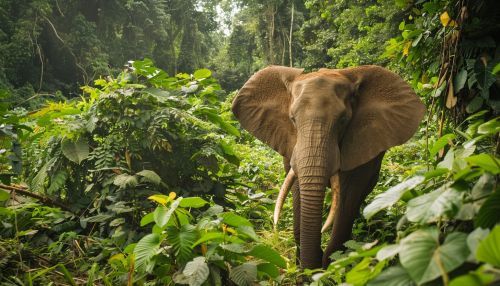Forest elephant
Introduction
The forest elephant, scientifically known as Loxodonta cyclotis, is one of the three extant species of elephants, alongside the African bush elephant and the Asian elephant. Native to the dense rainforests of Central and West Africa, forest elephants are distinct from their savanna-dwelling relatives in both physical characteristics and ecological roles. This article delves into the comprehensive biology, behavior, habitat, and conservation status of the forest elephant.
Taxonomy and Evolution
The forest elephant belongs to the family Elephantidae and the genus Loxodonta. The species was once considered a subspecies of the African bush elephant (Loxodonta africana) but has since been recognized as a distinct species due to significant genetic, morphological, and ecological differences.
Genetic Divergence
Genetic studies have revealed that forest elephants diverged from their savanna counterparts approximately 2-7 million years ago. This divergence is supported by differences in mitochondrial DNA and nuclear DNA, indicating a long period of evolutionary separation. The forest elephant's genome shows adaptations to the dense forest environment, such as smaller body size and straighter, downward-pointing tusks.
Morphological Differences
Forest elephants are generally smaller than African bush elephants, with males rarely exceeding 2.5 meters in shoulder height. They possess more rounded ears and straighter, thinner tusks, which are adapted for navigating through dense vegetation. Their skin is also darker and less wrinkled compared to their savanna relatives.
Habitat and Distribution
Forest elephants inhabit the tropical rainforests of Central and West Africa, with significant populations in countries such as Gabon, the Republic of Congo, and the Democratic Republic of Congo. They prefer dense, humid forests with abundant vegetation and water sources.
Ecological Role
Forest elephants play a crucial role in their ecosystems as megaherbivores. They are known as "ecosystem engineers" because their feeding habits help shape the forest structure. By consuming large quantities of vegetation, they create clearings that allow sunlight to reach the forest floor, promoting the growth of a diverse range of plant species. Their dung also helps disperse seeds, contributing to forest regeneration.


Behavior and Social Structure
Forest elephants exhibit complex social behaviors and live in matriarchal family groups. These groups typically consist of a matriarch, her offspring, and other related females and their young.
Communication
Forest elephants communicate using a variety of vocalizations, including low-frequency rumbles that can travel long distances through the dense forest. These vocalizations are crucial for maintaining group cohesion and coordinating movements. They also use visual signals, such as ear flapping and trunk gestures, to convey information.
Feeding and Foraging
Forest elephants are primarily herbivorous, feeding on a wide range of plant materials, including leaves, fruits, bark, and roots. They have a preference for certain tree species and are known to travel long distances to find their preferred food sources. Their foraging behavior significantly impacts forest composition and biodiversity.
Reproduction and Lifespan
Forest elephants have a slow reproductive rate, with females giving birth to a single calf every 5-6 years. The gestation period lasts approximately 22 months, the longest of any land mammal. Calves are dependent on their mothers for several years, learning essential survival skills through social interactions within the family group.
Lifespan
In the wild, forest elephants can live up to 60-70 years, although their lifespan is often reduced due to threats such as poaching and habitat loss. Their long lifespan and slow reproductive rate make them particularly vulnerable to population declines.
Conservation Status
The forest elephant is classified as Critically Endangered by the IUCN. Major threats to their survival include poaching for ivory, habitat destruction, and human-wildlife conflict.
Poaching and Ivory Trade
Forest elephants are heavily targeted by poachers due to the high value of their ivory, which is denser and more valuable than that of savanna elephants. Despite international bans on ivory trade, illegal poaching remains a significant threat, driven by demand in global markets.
Habitat Loss
Deforestation and habitat fragmentation due to logging, agriculture, and infrastructure development have severely impacted forest elephant populations. The loss of habitat not only reduces available resources but also increases the likelihood of human-elephant conflicts.
Conservation Efforts
Conservation efforts for forest elephants include anti-poaching initiatives, habitat protection, and community-based conservation programs. Organizations such as the WWF and the WCS are actively involved in efforts to protect forest elephant populations and their habitats.
See Also
- African bush elephant
- Asian elephant
- Megaherbivores
- International Union for Conservation of Nature
- World Wildlife Fund
- Wildlife Conservation Society
